BUCYRUS RAILROAD STEAM SHOVEL
LAKE GOLDSMITH STEAM PRESERVATION ASSOCIATION, 1234 CARNGHAM-LAKE GOLDSMITH ROAD LAKE GOLDSMITH, PYRENEES SHIRE
-
Add to tour
You must log in to do that.
-
Share
-
Shortlist place
You must log in to do that.
- Download report
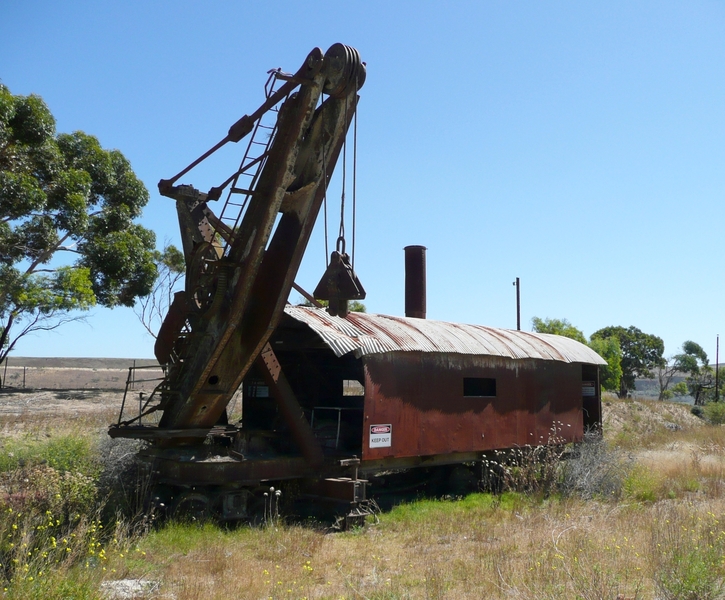

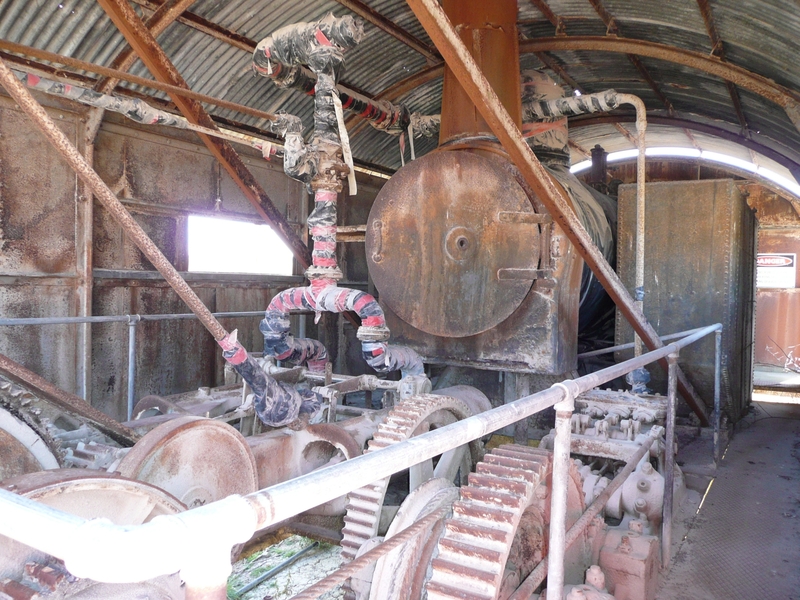
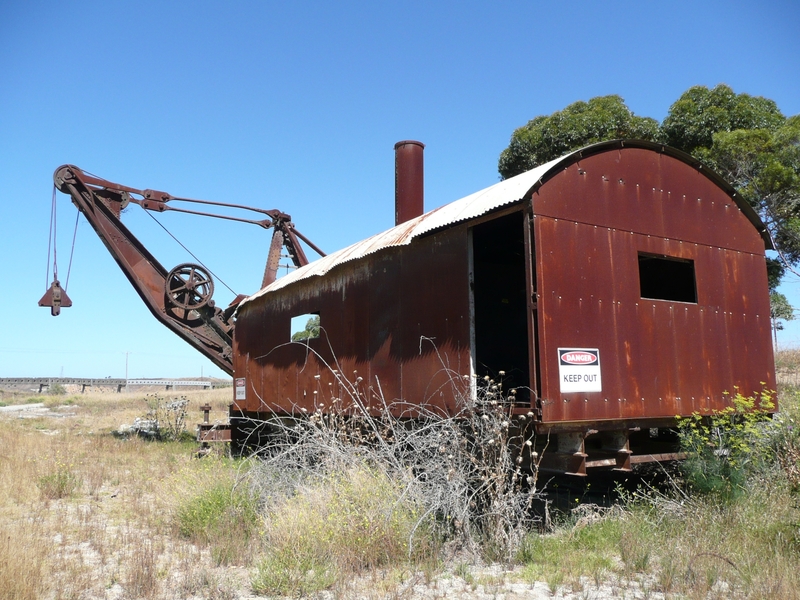
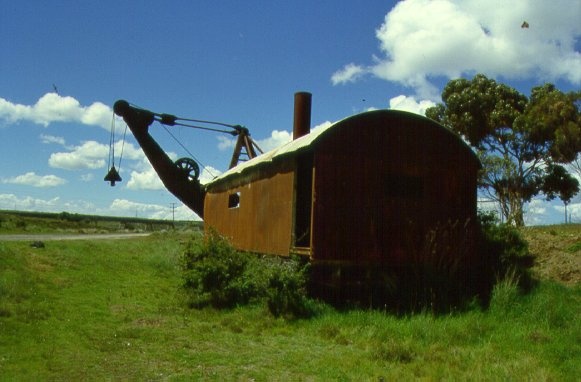
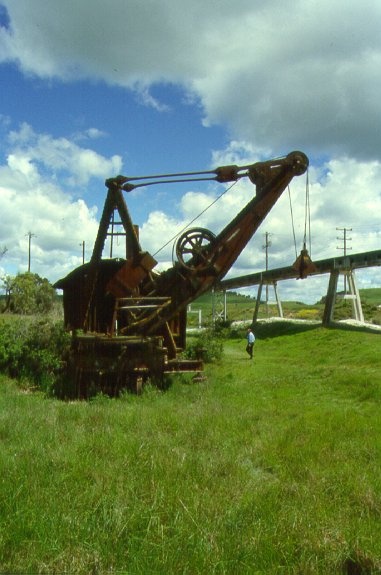
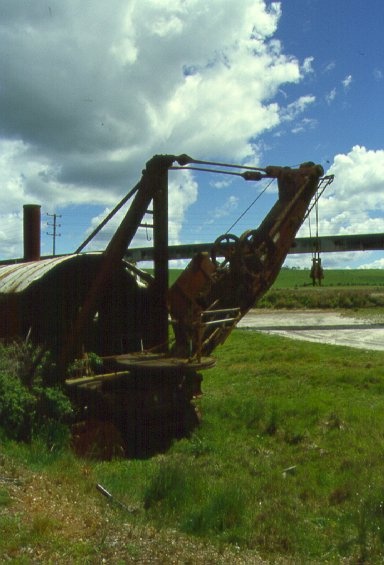
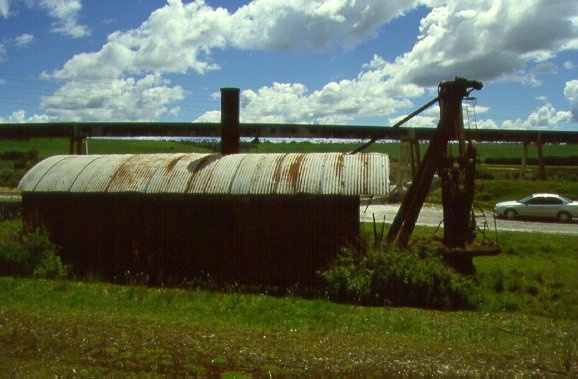
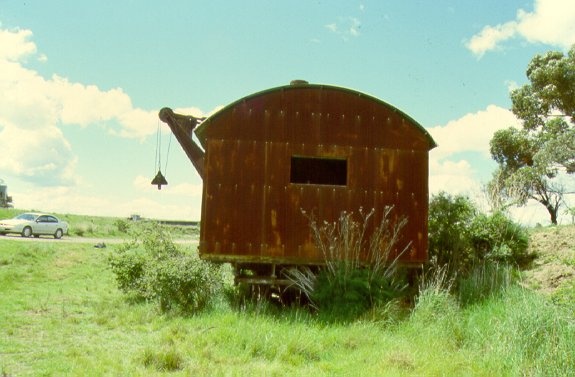
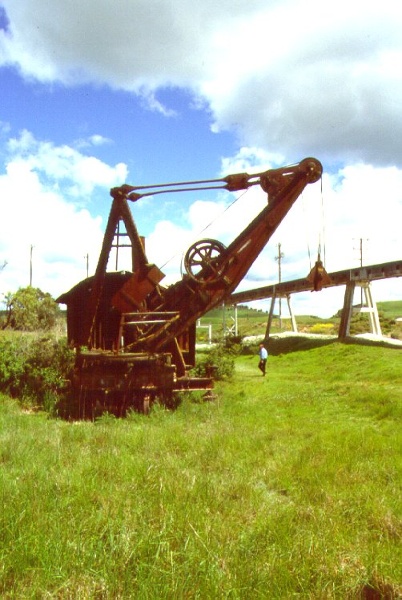
Statement of Significance
What is significant?
The Bucyrus Railroad Steam Shovel, manufactured in 1903 by The Bucyrus Co, South Milwaukee and located at Geelong Cement's Batesford quarry, Fyansford is a rail-mounted, fixed-platform, limited slew steam powered shovel. The steam shovel comprises a steel platform supported on two four wheel rail bogies, and weighs 65 tons. The shovel is mounted at one end of the platform and can slew 180 degrees. Mounted on the platform, and contained within the housing, are a horizontal locomotive type boiler, and horizontal steam engines. The three engines provide motion to move the entire excavator, and hoisting, slewing, and thrusting action for the shovel boom, dipper, and bucket. It has been dormant on rails at the top of the quarry since the 1960s. The dipper and bucket are missing and the boom converted for use as a crane.
The fixed-platform limited-slew arrangement in which the shovel is pivoted from one end of the platform was the basis of the first successful shovel in 1835. Shovels developed from this first machine followed the same basic layout until the present design of a fully slewing machine was developed. The shovel is also mounted on railway type bogies, which was the only feasible method of supporting these heavy shovels, and providing some mobility prior to the development of crawler tracks. The shovel, built in 1903, predates the development of crawler tracks (first applied to agricultural tractors in 1904). Crawler tracks were experimented with first by Bucyrus in 1905 but were not used on larger shovels until 1911, after which crawler tracks soon displaced rail mounting. Many rail mounted shovels were retrofitted with crawler tracks to improve their mobility.
The shovel was first used at the Mount Morgan gold mine, Queensland and commenced operation in September 1903 removing overburden. In 1908 it was rented to the Rockhampton Harbour Board, which used the shovel until 1923, when it was transported to Brisbane and used on the city's sewerage construction project. Later it was sold to Australian Portland Cement (now Geelong Cement), Victoria's largest cement producer, where it is thought to have begun work in the early 1920s. The shovel worked until the 1960s when it was retired. It was removed from the Geelong Cement Quarry, Batesford in 2010 in preparation for the closure of the quarry.
How is it significant?
The Bucyrus rail-mounted steam shovel is of historical, and scientific (technical) significance to the State of Victoria.
Why is it significant?
The Bucyrus rail-mounted steam shovel is of historical significance because of its association with some major Australian mining, quarrying, and construction projects. It is a rare surviving example of early machinery associated with the Geelong Cement plant.
The Bucyrus rail-mounted steam shovel is of scientific (technical) significance because it demonstrates an evolutionary period of excavator design in regard to shovel movement, machine mounting, and powering.. This shovel is the only known Bucyrus shovel of its type in the world to retain its original rail mounting. It is both the oldest known shovel, and the only example of its type, in Australia, and the world.
The shovel is of scientific (technical) significance because it demonstrates the steam powered method of powering an early generation of mechanical excavators.
-
-
BUCYRUS RAILROAD STEAM SHOVEL - History
CONTEXTUAL HISTORY AND History of Place:
The 65 ton steam shovel now at Fyansford was manufactured by The Bucyrus Co., Wisconsin, Milwaukee, USA in 1903. It was purchased by the Mount Morgan Gold Mining Company in July 1903 at a cost of 2662 pounds and assembled on the mountain top. In September 1903 the shovel commenced operations removing overburden at the 196 ft level of the open cut mine. In January 1904 it was moved to the 252 ft level, and in May 1907 it was moved to the 315 ft bench where it remained until its work was completed on 26 May 1908. The shovel was worked 16 hours per day, and 30 men were employed on each 8 hour shift maintaining production. During its time at Mt Morgan it is estimated the shovel moved 831,430 tons of material. It was the first steam shovel used at the mine.
After completing its work at Mt Morgan, the shovel was rented to the Rockhampton Harbour Board, at two pounds per week, to excavate bluestone rocks for building retaining walls along the banks of the Fitzroy river. The shovel worked from 12 October 1908 to 31 March 1910 moving 165,820 tons of rock in 316 working days. The shovel remained in the Rockhampton area until c.1923 when it was transported to Brisbane to work on the city's sewerage construction project. Later it was sold to the Australian Portland Cement (APC) works at Fyansford near Geelong. The exact date when the shovel was bought is not clear, though there is a Victorian boiler inspection test date stamped on the boiler of August 1923.
The shovel worked in the Batesford quarry directly loading the railway wagons with limestone. The Batesford quarry was the source of all limestone used in the manufacture of cement at APC. APC used a number of steam shovels at the quarry. These were replaced by Marion diesel powered cable shovels in 1958. The steam shovels were relegated to support duties and gradually phased out. The cable shovels have since been replaced by hydraulic diesel excavators. The railway system in the quarry was also replaced by truck haulage and an overland conveyor.
The original wooden housing of the Bucyrus shovel was replaced with a sheet steel housing in January 1939. During the 1960s the shovel was withdrawn from excavation duties and parked on a railway siding at the top of the quarry. The shovel and dipper arm were removed, and the shovel was rigged as a crane. The shovel and dipper were scrapped. The shovel was used as a crane and operated on compressed air instead of steam. Late in the 1960s the railway system operated by APC was replaced with an overland conveyor system and the railway siding was no longer used. The shovel has been left here ever since. The Bucyrus shovel was unique within the Fyansford quarry. All other shovels used by APC were full-slew types and crawler mounted.BUCYRUS RAILROAD STEAM SHOVEL - Plaque Citation
The Bucyrus Steam Shovel.
First used at Mt Morgan goldmine in Queensland, the rail-mounted shovel,built in 1903 in South Milwaukee, USA, operated at a cement quarry near Geelong from 1923 to the 1960s.
BUCYRUS RAILROAD STEAM SHOVEL - Assessment Against Criteria
Criterion A
The historical importance, association with or relationship to Victoria's history of the place or object
The shovel is situated at the Geelong Cement Batesford quarry, Fyansford, where it has been since the early 1920s.
The shovel was an important item of plant for the movement of overburden and the quarrying of limestone used in the production of Portland cement and was purchased in a period of expansion at Victoria's largest cement producer, Geelong Cement.
Criterion B
The importance of a place or object in demonstrating rarity or uniqueness
The Bucyrus shovel is the only known example in Australia of a fixed-platform limited-slew railroad steam shovel. The first shovel built by Otis in 1835 was of this configuration. All manufacturers developed rail mounted fixed platform shovels with a mast to which the boom and dipper handle were attached. These were limited slew machines of between 140 and 200 degrees. The first full slew (360 degree) revolving shovel, where the undercarriage remained stationary, and the superstructure rotated fully was manufactured by Whittikar in Britain in 1884. The first full slew machine was not built in America until 1895, by Thew. This design did not completely displace large limited slew machines until the late 1920s. There is only a very small number of steam powered shovels remaining in Australia. With the exception of this shovel, all extant steam shovels are full-slew machines. All except one other are crawler track mounted
The Bucyrus shovel is the only known example in Australia of the largest class of railroad steam shovel (ie. limited slew & rail mounted) which dominated shovel manufacture prior to the introduction of full slew excavators, and smaller, lighter construction class machines.
The Bucyrus shovel is the only large steam shovel in Australia exhibiting the typical railroad configuration with a platform mounted on two four-wheel railway bogies.
The Bucyrus shovel is steam powered - a superseded method of power for mobile equipment. This railroad shovel features the only known extant application of a horizontal locomotive type boiler to a steam shovel in Australia. All full rotating shovels use vertical boilers.
The Bucyrus shovel is mounted on railway type wheels, and is moved along portable railway track. This illustrates the method of moving large machines prior to the introduction of crawler tracks. This shovel, built in 1903, pre-dates the application of crawler tracks. Crawler mounting is the only method used today for large mining shovels today. Most shovels built around 1900 were mounted on railway tracks. There was limited application of broad rimmed metal wheels for lighter shovels used in construction and road building. Due to the size of the machine, and the terrain, large shovels used in railway, mining and quarrying continued to be mounted on rails. Rail mounting had limitations on mobility and Bucyrus was the first company to apply crawler tracks to large excavators. The first commercially successful application of crawlers to agricultural tractors by Holt was achieved in 1904. In 1905 Bucyrus started to apply similar tracks to excavators but it was not it was truly applied to a heavy excavator (a 62 ton dragline) until 1911. Crawlers sets were offered by Bucyrus to retrofit rail mounted shovels. This shovel was not retrofitted and it is the only known shovel of its type in the world to retain the rail wheel bogie mounting. Other surviving examples of these shovels in the USA have been retrofitted during their working life.
Criterion C
The place or object's potential to educate, illustrate or provide further scientific investigation in relation to Victoria's cultural heritage
The shovel has educational and tourism potential for interpretation, and demonstration of an excavation method, working conditions, and machine design features which are no longer practiced.
The shovel has the potential to contribute to the history of quarrying and cement production in Victoria.
The shovel was one of a number of steam shovels to comprise the first generation of mechanised aids used in the quarry. The steam shovel replaced hand loading of drays and represents a significant step in the mechanisation of the quarry workings.
Criterion D
The importance of a place or object in exhibiting the principal characteristics or the representative nature of a place or object as part of a class or type of places or objects
This is a large and relatively intact example of steam shovel, and uniquely demonstrates an early period in the evolution of the mechanical excavator.
Criterion E
The importance of the place or object in exhibiting good design or aesthetic characteristics and/or in exhibiting a richness, diversity or unusual integration of features
Criterion F
The importance of the place or object in demonstrating or being associated with scientific or technical innovations or achievements
The Bucyrus shovel is important as an example of the first generation of excavators. The shovel demonstrates the application of steam power to early excavators, and the method of imparting shovel movement through chains and steam winches, the mounting of large machines for mobility, and the design of shovel mechanisms.
Criterion G
The importance of the place or object in demonstrating social or cultural associations
The Bucyrus shovel was one of the first labour saving machines to be used in quarrying and mining operations for the increase of production, and replaced hand quarrying and loading wagons.
Criterion H
Any other matter which the Council deems relevant to the determination of cultural heritage significance
The long period of active service of the shovel, from 1903 through to the 1960s, when it was finally superseded by more modern machines.
The mechanical completeness of the core machinery (engines, boiler, boom, platform & bogies) along with an unaltered state since its last use in the 1960s add to its integrity.
The diversity of projects worked on is not limited to Geelong Cement, but also Mt Morgan mine, Rockhampton Harbour Board, and Brisbane main sewer project in Queensland. It was the first steam shovel at Mount Morgan, and was the first mechanical excavator used in mining in Queensland.BUCYRUS RAILROAD STEAM SHOVEL - Permit Exemptions
General Exemptions:General exemptions apply to all places and objects included in the Victorian Heritage Register (VHR). General exemptions have been designed to allow everyday activities, maintenance and changes to your property, which don’t harm its cultural heritage significance, to proceed without the need to obtain approvals under the Heritage Act 2017.Places of worship: In some circumstances, you can alter a place of worship to accommodate religious practices without a permit, but you must notify the Executive Director of Heritage Victoria before you start the works or activities at least 20 business days before the works or activities are to commence.Subdivision/consolidation: Permit exemptions exist for some subdivisions and consolidations. If the subdivision or consolidation is in accordance with a planning permit granted under Part 4 of the Planning and Environment Act 1987 and the application for the planning permit was referred to the Executive Director of Heritage Victoria as a determining referral authority, a permit is not required.Specific exemptions may also apply to your registered place or object. If applicable, these are listed below. Specific exemptions are tailored to the conservation and management needs of an individual registered place or object and set out works and activities that are exempt from the requirements of a permit. Specific exemptions prevail if they conflict with general exemptions. Find out more about heritage permit exemptions here.Specific Exemptions:
General Conditions:
1. All exempted alterations are to be planned and carried out in a manner which prevents damage to the fabric of the registered object.
2. Should it become apparent during further inspection or the carrying out of alterations that original or previously hidden or inaccessible details of the object are revealed which relate to the significance of the object, then the exemption covering such alteration shall cease and the Executive Director shall be notified as soon as possible.
3. If there is a conservation policy and plan approved by the Executive Director, all works shall be in accordance with it.
4. Nothing in this determination prevents the Executive Director from amending or rescinding all or any of the permit exemptions.
BUCYRUS RAILROAD STEAM SHOVEL - Permit Exemption Policy
The policy below has been specifically developed for registered objects and collections in the ownership/custodianship of incorporated and community based organisations, where no standard collections management policies are in place. .
Permit exemptions will only be granted where the incorporated and community based organisation with responsibility for the registered heritage object or collection has developed a Conservation Management Policy [CMP] for the object, and that CMP has been endorsed by the Executive Director.
Once an endorsed CMP has been implemented, the object type may be subject to a review to enable a class of standard, or specific, permit exemptions to be granted.
.
-
-
-
-
-
BUCYRUS RAILROAD STEAM SHOVEL
 Victorian Heritage Register H1918
Victorian Heritage Register H1918
-
'Mororo' 13 Oxford Street, Malvern
 Stonnington City
Stonnington City -
1 Arnold Street
 Yarra City
Yarra City -
1 Austin Street
 Yarra City
Yarra City
-
-










